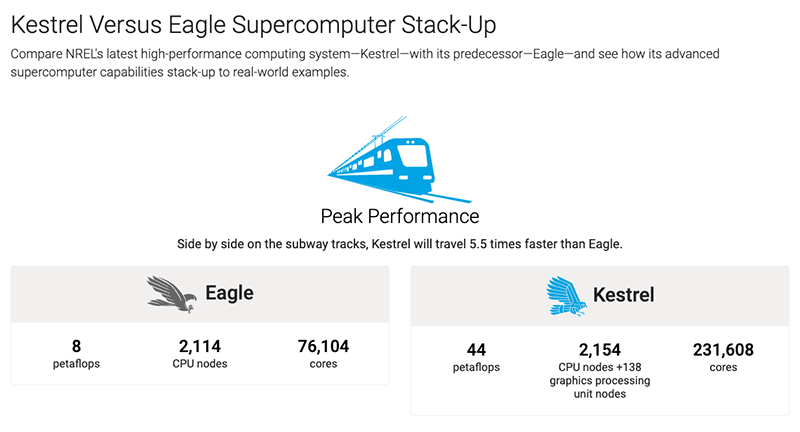Kestrel new supercomputer. The U.S. Department of Energy (DOE) announced this week that installation of the new high-performance computing (HPC) system, Kestrel, has begun. Firstly, this new supercomputer will advance energy technologies spanning multiple Office of Energy Efficiency and Renewable Energy (EERE) programs and deliver transformative energy solutions more than five times that of EERE’s current HPC, Eagle.
Secondly, both computers are housed at the National Renewable Energy Laboratory (NREL) in Golden, Colorado. They are used for various computer simulations and modeling, like optimizing locations within disadvantaged communities for new electric vehicle charging infrastructure or modeling atomic and electronic behavior to improve solar cell manufacturing.
The Manufacturer
Moreover, Kestrel is being built by Hewlett Packard Enterprise (HPE). The company expects to be fully compatible with the warm-water waste heat recovery system. It is currently used in NREL’s Energy Systems Integration Facility (ESIF) data center, which will complement Eagle during the transition. This week’s arrival marks the beginning of the first phase of the Kestrel build—once phase one is complete, Kestrel will be fully operational and able to support research. Phase two, comprising the graphics processing unit (GPU)—or “accelerator”—nodes, will be added to Kestrel this fall.
Kestrel will play a critical role in computing across the research portfolio, advancing research in computational materials. At the same time, continuum mechanics, large-scale simulation, and planning for future energy systems. Additionally, the new system’s heterogeneous architecture includes CPU-only and GPU-accelerated nodes. It is designed to enable these emerging workflows, allowing EERE to tackle the energy challenges five times faster than yesterday toward a renewable and sustainable future.
Supercomputers and artificial intelligence
“Supercomputers like Kestrel are critical to the energy transition,” said Acting Assistant Secretary Alejandro Moreno. “Kestrel will enable the EERE research community to apply cutting-edge simulations and harness artificial intelligence to advance affordable, reliable, clean energy technologies at the scale we need to reach our country’s climate and energy goals.”
Link of interest: Nuclear fuel to Dry Storage
Kestrel’s rapid computational speed and advanced artificial intelligence and machine learning capabilities will help the EERE research community. It will be able to apply cutting-edge simulations and tackle energy challenges at an unprecedented speed. And it will lead to a renewable and sustainable future.
With the Kestrel HPC system in progress, NREL remains poised to continue delivering critical energy efficiency and renewable energy advancements with its HPC-supported capabilities. Besides, the arrival of Kestrel marks a new era of computational innovation. It will enable researchers to simulate complex phenomena in energy and material science. In conclusion, this innovation will be instrumental in advancing our understanding of energy systems. It will drive breakthroughs in renewable energy and help to transition the world to a more sustainable future.
Link of interest: Office of Energy Efficiency & Renewable Energy


